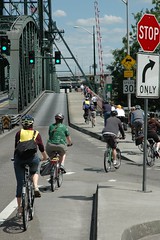
When I’ve worked downtown, the highlight of my commute has always been crossing the Hawthorne Bridge. The air quality changes, the breeze shifts, the river is right below you, and the view of other bridges, buildings, and if you’re lucky, a big freighter, make you feel connected to the city.
Then someone nearly steps in your path, or zooms past you without warning, and you have to slow down and focus on your immediate five-foot bubble to avoid hitting someone (or getting hit yourself).
Let’s face it — traffic congestion on the Hawthorne Bridge is a serious problem, and I don’t mean in the motor vehicle lanes.

The new bike/pedestrian lane markings on the bridge have helped a lot. But cyclists in a hurry still court danger by passing on the right, and lunchtime power-walkers are still oblivious to all other users.
“Most Portland roads push cyclists and walkers together at the road margins and leave us to battle amongst ourselves for this narrow allotment.”
–Elly Blue
And yet — as you ride across the bridge, you feel that something isn’t quite right. You’re crammed onto the sidewalk with lycra’d-out racers silently scorching past on your left, and joggers and walkers suspiciously eyeing you (or worse, obliviously roaming all over the path) on your right.
Most Portland roads push cyclists and walkers together at the margins and leave us to battle amongst ourselves for this narrow allotment. The situation on the Hawthorne Bridge is especially bad because most of the day, bike and pedestrian congestion is steady but there is very little traffic in the car lanes.
Motorists have it pretty nice on the Hawthorne Bridge — except during rush hour. This kind of congestion shouldn’t happen. I suspect that if traffic were just a bit worse, that would be the tipping point for people who could bike, bus, and carpool to do so. Meanwhile, the bus becomes a less viable option as traffic becomes worse.
How can we untangle the dangerous bicycle-pedestrian collision course on the too-narrow sidewalks?
How can we streamline bus travel, providing a key incentive to cut down on car traffic?
How can we reduce dangerous car speeds on (and therefore coming off) the bridge during non-peak hours?
There’s one proposal I’ve heard offered over the years in which everybody, seemingly, wins. Here it is: reduce car traffic on the bridge to the two center lanes, and dedicate the outer two to bicycles. Have one of these lanes be an express bus lane during morning and evening rush hours, westbound and eastbound respectively.
This is a win-win-win-win-win situation:
- Pedestrians can walk freely, no longer fearful of colliding with anything more damaging than a rogue stroller.
- Cyclists, even if sharing one former car lane for two directions of travel, will have room to enjoy the view on the right and train for the Tour de France on the left.
- Bus riders can enjoy the full value of their $1.70 (and rising), and TriMet can enjoy increased ridership.
- People who have yet to exercise their option of busing, biking, or carpooling to work can discover the pleasures of those modes.
- Those who have no choice but to drive can take for granted the reduced congestion that we in the United States are only beginning to realize comes along with “road diets” such as this one.
This suggestion might seem counterintuitive to some people, but if we try it for six months I’m positive that no one will want to return to the cramped and congested status quo.
Are you listening, (Multnomah County Chair) Ted Wheeler et al.? We need to make the Hawthorne Bridge work better for ALL users and we have everything to gain from thinking outside the box.


